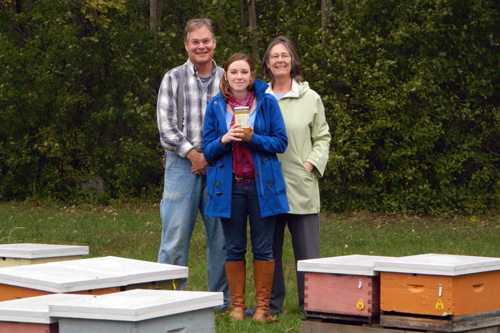
As an emergency clinician, who also trained as a veterinary surgeon, professor emerita Karol Mathews was always looking for new ways of treating wounds and helping animals heal.
“While researching the various treatments for infected and contaminated wounds, I came across studies that found honey was quite effective,” she says. In fact, she learned that honey had been used on wounds for at least 6,000 years and is mentioned as a treatment in both the Bible and the Qur’an.
When a dog was brought to the Small Animal Clinic from the Humane Society in 1998, she decided to give it a try. “As luck would have it,” she jokes, “we happen to have an apiary on campus.”
Paul Kelly, a beekeeper at U of G’s Honey Bee Research Laboratory, gave her a sample of raw honey to use on the beagle, which had been injured in a barn fire 10 days earlier. The dog’s skin had been burned from its head to its tail and was infected with five different kinds of bacteria. Although the dog was given antibiotics for the infection, the lack of blood flow to the damaged skin meant the antibiotics weren’t active at the wound site.
After two days of applying the honey, there was no further bacterial growth. The debris and dead tissue was cleansed away by the honey and there was visible healing in the bottom of the wound and the edges of the skin.
Mathews was sold and has used honey to manage wounds ever since. “With the rise in acquired antibiotic resistance by microbes, I think honey can play a very important role. It not only kills the infecting agent, whether bacterial or fungal, it helps the injured tissues heal,” she says. Despite honey’s long history of use, bacteria have not developed resistance. Honey can also prevent the formation of biofilms, which bacteria create to protect themselves, and honey also appears to break down the biofilm and kill the bacteria within it.
Pasteurized honey, Mathews explains, has been heated to at least 60 C for about 30 minutes. This effectively kills bacteria, yeast spores and fungi potentially in the honey but also halts the action of the enzymes believed to be beneficial for wound healing and antibacterial activity. Non-pasteurized honey is often heated to remove any crystals that may be present. Mathews says that the heat is not always well-controlled and can sometimes exceed the levels at which the heat-sensitive enzymes are affected. Raw honey, on the other hand, is simply centrifuged from the honeycomb with no heat applied.
The most extensive research on the anti-infective and healing properties of honey comes from New Zealand, where honey from bees that have gathered nectar from the manuka (Leptospermum) bush has been shown to be particularly effective at killing bacteria and fungi.
“In New Zealand, this manuka honey is gamma irradiated to kill bacteria and spores that are occasionally present, then impregnated in bandages and sold as a medicinal agent,” Mathews says. The impregnated bandages (called Medihoney™ by Derma Sciences in Toronto) are used in Canada as well, including Sunnybrook Hospital. They are highly effective in treating contaminated wounds and bed sores, a common problem in elderly patients.
Now Mathews has partnered with Paul Kelly, Dr. Brigitte Brisson, Prof. Carlton Gyles, Prof. Scott Weese, Prof. Ernesto Guzman and graduate student Jessica Pask to study the antibacterial effects of honey from Southern Ontario. Currently, Mathews uses whatever U of G raw honey is available when an animal needs treatment. However, her research will involve testing the honey throughout the season, when the bees are travelling to different plants and trees to collect nectar, and analyzing the components of each sample to identify the plant source of the “best antibacterial” batches of honey. A clinical testing phase will follow to determine the effectiveness of this honey, compared to currently available wound care products, when applied directly to wounds.
Mathews is excited about the potential for healing with honey and hopes this research will provide support for a valuable new option for wound management.
“With antibiotic-resistant bacteria on the rise, people are looking for something else that will be effective and yet not too expensive,” says Mathews. “New Zealand has paved the way, and this research can help to establish the value of our local honey in these situations. It may be a new opportunity for beekeepers as well.”
The research was funded by the Ontario Veterinary College Pet Trust.
If you’re interested in buying honey on campus, visit the Honey Bee Research Centre.